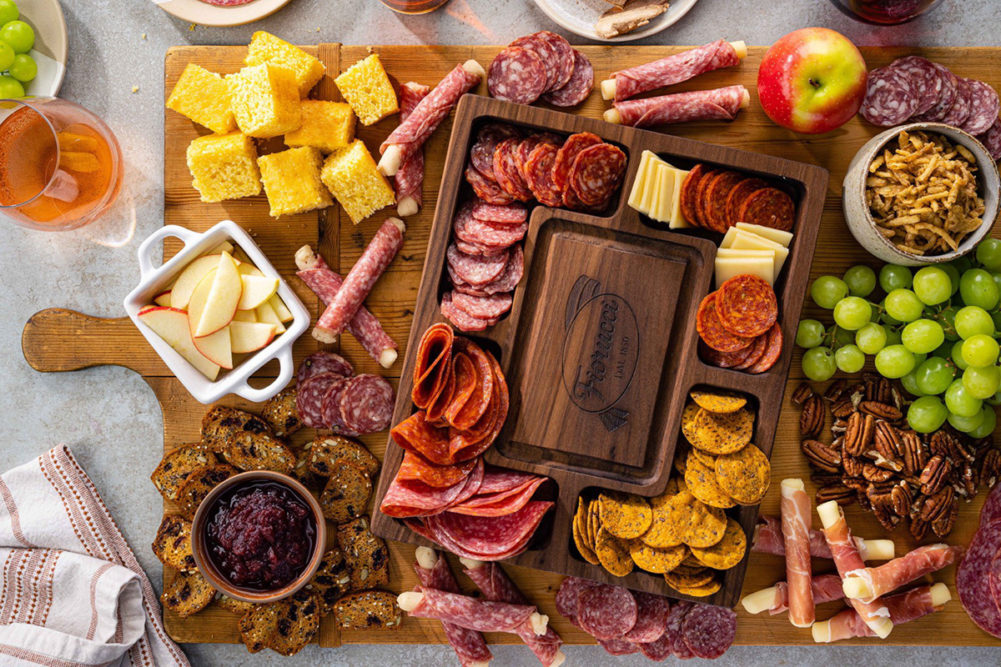The charcuterie craze of recent years has led to a surge in demand for imported specialty meats in US grocery stores, and suppliers are meeting the demand with greater volumes and new products.
Sigma USA imports Italian meats branded under its flagship Fiorucci label and Spanish meats under the Campofrio banner. And in 2022, the company added a plant-based brand, Better Balance. The Campofrio line has also been in the Sigma portfolio for less than a year.
Bulk and pre-sliced prosciutto di parma is the heavy lifter for Fiorucci, said Shawn Munck, the company’s marketing director. The company also imports mortadella, though Munck said recent supply chain challenges have limited volumes of that product.
Bulk and pre-sliced serrano from Spain is the top product in the Campofrio line. Product comes from small deli packs to entire legs, Munck said.
The Better Balance line, meanwhile, includes plant-based shreds and other products that mimic the flavors of chicken, beef and pork. Made in Mexico, they are primarily targeted for foodservice.
Bulk prosciutto di parma has long been a staple for Fiorucci. In pre-sliced, the 3-ounce has been the company’s main item, but recently, Fiorucci added a 12-ounce pack, largely targeted at Sam’s Club, BJ’s and other club stores, Munck said.
Supply chain challenges led to a stop-and-start beginning to the program, but volumes of pre-sliced and bulk product are steady now.
“We’ve started to get traction in more specialty and Hispanic markets,” Munck said. “Even though it’s a Spanish product there’s a lot of consumer affinity for it with Hispanics.”
For Lent, Easter and other specific times of the year, demand has been high for whole legs and other large products, Munck said. Expect to see new products in the line during the fourth quarter of this year, he predicted. Higher-end stores like Wegmans and Pavilions have been especially receptive to the new Spanish product. Some is also moving in places like Costco, too, he said.
Selling imported deli meats can give grocery retailers a point of differentiation from their competitors, Munck said. And more and more are getting that message.
“I wouldn’t say prosciutto di parma is mainstream, but Italian is definitely mainstream,” he said. “Spanish is a bit more niche. It’s popular in areas where there are big Hispanic populations, like the Northeast, California and Texas.”
Charcuterie’s role
It’s no mystery what’s driving demand for imported meats, Munck said: the continuing explosion in popularity of charcuterie.
“Charcuterie has been one of the top appetizer trends in restaurants, and what starts in restaurants goes down to retail. Charcuterie gives consumers a lot of customization. And a lot more people are going back to entertaining again, getting back together, and they’re interested in experiencing global foods.”
The imported influence can even be felt in some of Sigma’s domestically-made deli meats. Fiorucci Calabrese, for instance, is made in the US, but the spices used in the production from the Calabria region of Italy.
Sigma also continues to see growth in sales of variety packs designed for sandwiches, which contain salami, pepperoni and prosciutto or soppressata.
“We’ve recently had strong distribution with a couple of national retailers,” Munck said.
Looking ahead, Sigma is expecting big growth in on-the-go Italian and Spanish deli meat snacking products, Munck said.
“More grocery stores, like Walmart, are expanding with grab-and-go sections, charcuterie in more of a compact form.”
In its panino snacking line, Fiorucci is trying to diversity, with new flavors like pizza, pepperoni pepperjack and fruit-infused, Munck said. Sigma had a successful trail run of some of the new products with Publix, part of the chain’s 100 Days of Summer promotion. “We’ll protect our core portfolio, but also look into more seasonal and LTO opportunities, too,” Munck said. In 2024, Sigma will also be focusing on more all-natural, clean-label imported deli meat products. Part of that has to do with the implementation of California’s Prop 12, part with consumer demand across the country.
“We continue to see consumers looking at what they’re buying, looking at ingredient statements, and we’re providing the cleanest labels we can.”
This article is an excerpt from the September 2023 issue of Supermarket Perimeter. You can read the entire Imported Meats feature and more in the digital edition here.

